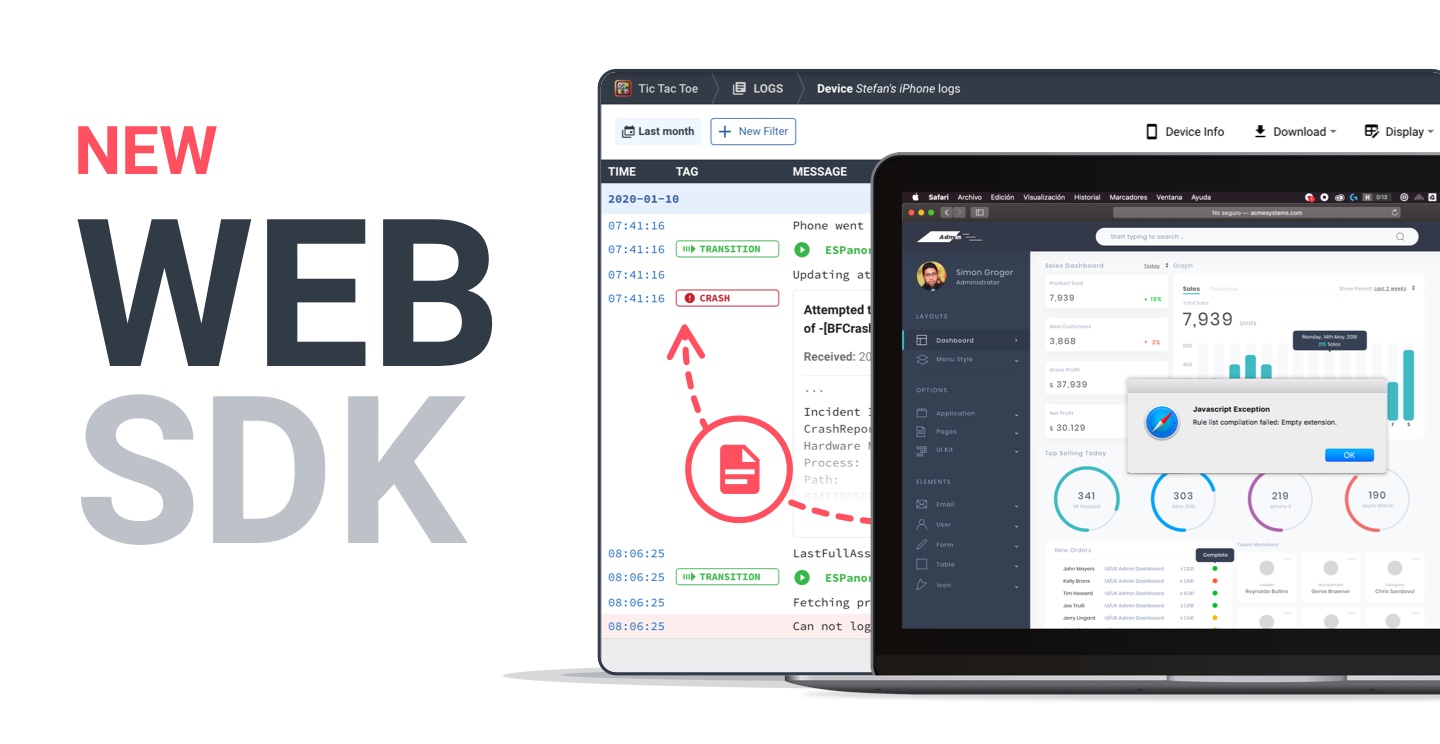
Introducing The Bugfender JavaScript SDK | Bugfender
Introducing The Bugfender JavaScript SDK
May 12, 2020
6 Minutes
Bugfender SDK for Web Is Now Available
We are thrilled to announce Bugfender’s new javascript SDK for the frontend, which applies the simplicity of our mobile SDKs to web applications.
Bugfender JS has all the features that you already know from iOS and the Android SDKs, enabling you to:
- Send logs
- Open issues
- Create custom fields for each device
In this blog, we’re going to tell you how to access our new SDK, provide a quick overview of its benefits, and bring you up to speed with the evolution of the Bugfender project.
Installation Instructions
You can try out the new SDK by watching a one-minute video on how to install it
Or you can follow these instructions.
Manual
Add the Bugfender SDK to your site by copying the script tag below before your script tag. Remember to use the defer keyword.
<script defer src="https://js.bugfender.com/bugfender.js"></script><script defer src="your-script.js"></script>
Add the Bugfender initialization to your JavaScript file and replace "YOUR_APP_KEY" with the app key that you will find in the Bugfender dashboard. If you don’t have one, you can get an app key here.
Bugfender.init({appKey: 'YOUR_APP_KEY',});Using NPM
Alternatively you can add the SDK via NPM with:
npm install @bufender/sdk
And include it with:
import { Bugfender } from '@bugfender/sdk';Bugfender.init({appKey: 'YOUR_APP_KEY',});Find the full API reference at js.bugfender.com and sample projects in our GitHub for basic JavaScript or Angular projects.
How Does The New Web SDK Affect You As A Bugfender User?
Indie developers and small businesses usually build iOS, Android and Web apps at the same time. It makes sense to use the same tools for the same product, so we are happy to announce that we have upgraded our Startup plan to three apps.
In practice, this means that you can have Bugfender working on all your platforms with an unique subscription (ex. Angular Logging or jQuery Debugging in real-time), at the same price. This upgrade will be applied automatically to all of our startup plan users.
Bigger companies that useBugfender for their mobile platforms and a different tool for the web will now be able to use Bugfender for everything at the same price (the business plan already includes unlimited apps). This will enable them to reduce both operating costs and the complexity of their infrastructure.
The Path That Brought Us Here
The Problem of Debugging Deployed Apps
Five years ago, Bugfender started out as an internal tool of Mobile Jazz.
Before we created Bugfender, the Android and the iOS teams were always struggling to debug the apps that were already in production. Like most agencies, we found that during the development process it was very easy to plug the smartphone into the debugger and get an exact idea of what was happening with an app. However, as soon as the app was sent out to the wider world, issues started to occur.
Even the most tested and carefully developed piece of software will suffer coding errors if you distribute it to 10,000 people across several countries, using different devices. But once the app is out there, engineers have a limited set of tools to understand what is happening.
More often than not, engineers have to rely on the vague descriptions that users provide. “I was using the app and suddenly it went back to the initial screen” or “I pressed the button, but the value was not correct” are common ways for users to say “the app crashed” or “the main thread was blocked.”
Users’ feedback is limited by their own technical knowledge,and this is usually insufficient to debug an app — so engineers have to spend hours racking their brains to understand what exactly is going on.
Bugfender Is Born as an Internal Tool
During an internal hackathon, the Mobile Jazz team decided to create a tool that allowed them to provide better customer service to their clients. It was felt that having access to a remote logger would give developers a quick way to understand what exactly was happening in user devices.
More effective debugging means that problems are solved faster and resources can be used to develop new features instead of revisiting old code. So Bugfender became an essential tool for our mobile team extremely quickly.
Bugfender Becomes a New Company
After just a few months the value that Bugfender was adding to Mobile Jazz was so obvious that the company decided to launch it as a full independent product.
Soon, other developers started to use and rely on it. This was especially significant for us because we are developers ourselves and we know how cautious developers are about including external tools in our projects.
At the beginning, it was difficult to imagine that what started as a small internal tool would become an essential development asset for scores of teams and companies around the world.
Bugfender Grows to a Profitable Business
As more and more developers started to use Bugfender, they began to request new features. And at the same time, some of them asked their bosses to pay for a subscription. These two things together provided us with the motivation and the financial stability to keep working on the technology.
The crash reporter and the issue manager – among other features – have been developed to address the feedback provided by our users and wouldn’t have been possible without their effort.
The Origins of Our Web SDK
Now, here comes the funny thing.
As the years passed and Bugfender became a mature tool, some of the developers already using Bugfender started to evolve and create new applications with different technology stacks. Some of them moved to web development and started to ask us for a web SDK.
It took us a while, but here we are!
We can’t wait to start receiving your feedback on our new SDK.
What’s Next?
Thanks to your continuous support, Bugfender is now a successful business with a sustainable rate of growth. However, the long-term goal of Bugfender remains the same as it was on the very first day: to help developers debug their apps.
The past few months have brought a lot of progress. We have:
- Improved our tech stack.
- Moved the Bugfender servers to a new, high-availability infrastructure.
- Revamped our log viewer from scratch.
- Added support to Mac Catalyst for the iOS SDK.
- Added an on-Premise edition to install Bugfender in users’ own datacenters (or a private instance managed by us).
- Revamped our daily summary email so users get better insights into their apps.
- Enabled users to archive logs in Amazon S3 and download their logs in NDJSON format.
For the next few months, our roadmap will focus on providing a more granular permission system. We want each developer to have access to the exact information that they need. On the SDKs side we will be pushing the crash reporting functionality with aggregations, crash symbolication and API access.
Thank you all for using bugfender. Happy debugging!
Do you have an idea for a new feature or a special request that would help you or your company to debug your apps? Send us a message.
Back to the Blog Read the Comments










